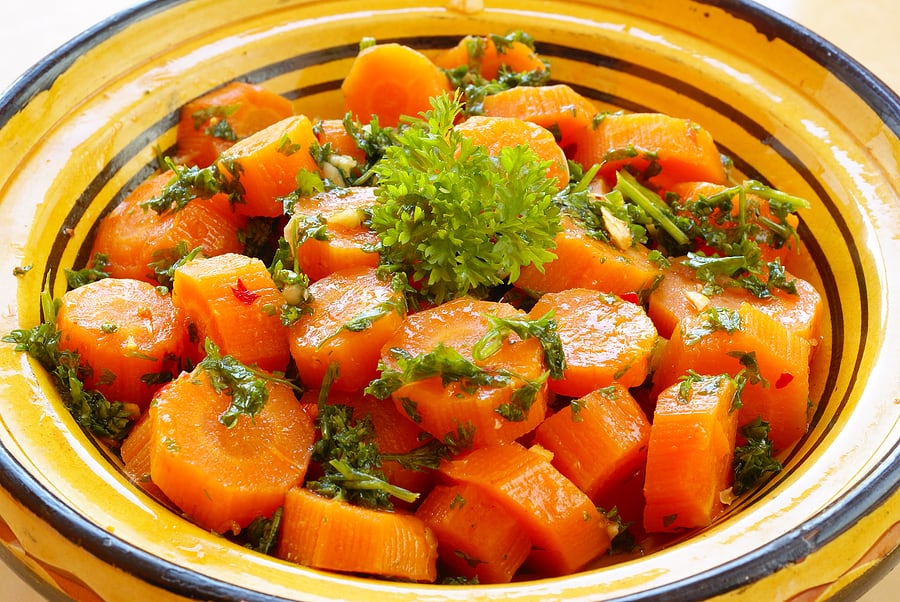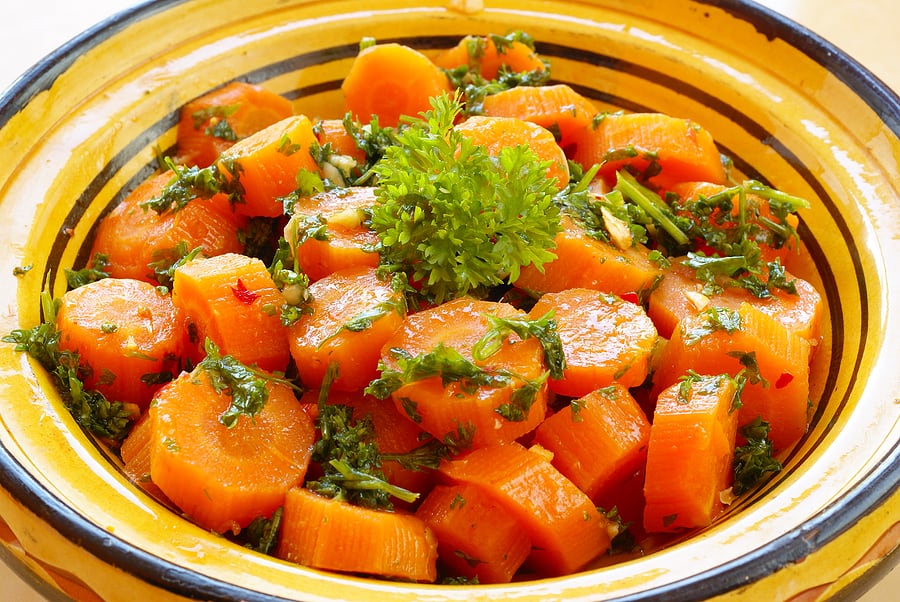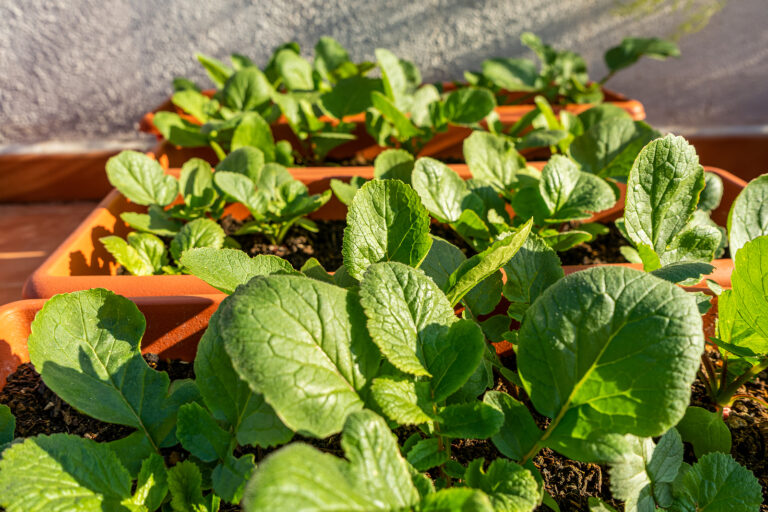Seven Ways to Cook and Serve Carrots
Carrots can be served raw or cooked. The key to serving the best-tasting carrots is to serve carrots that are not too small and not too large and to serve them as soon after harvest as possible.
You can eat carrots raw whole or in sticks or grated in a salad. Carrots can be used as a flavoring in broths or in savory soups and stews or cooked as a vegetable in their own right.
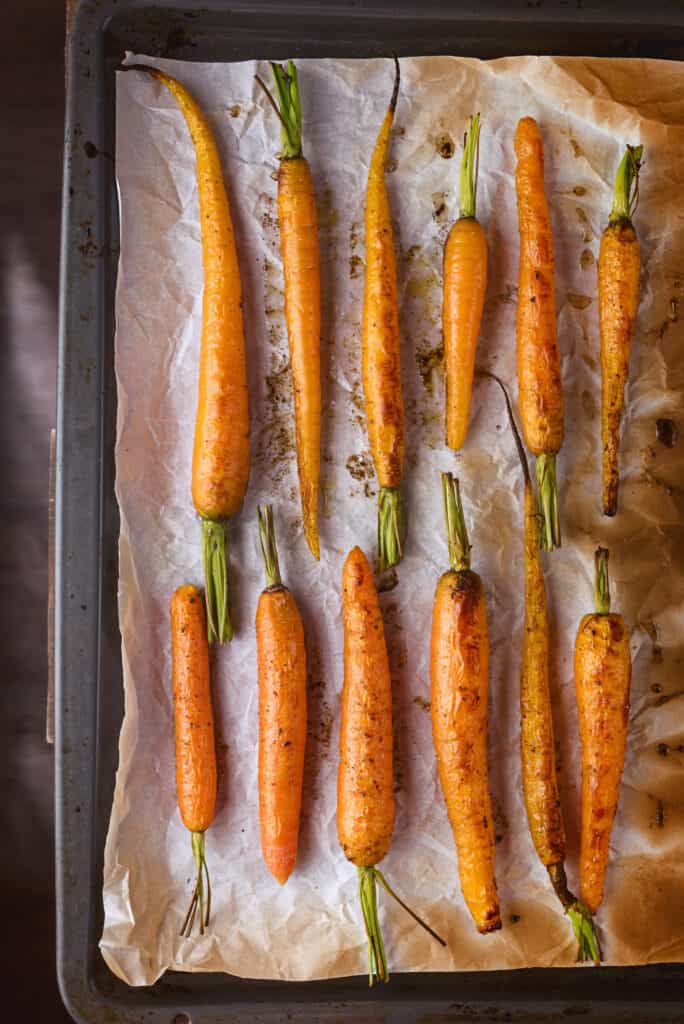
Because carrots have the highest sugar content of any vegetable after beets, they can find a place in any meal from appetizer to dessert.
Carrots are a cool-season biennial grown as an annual. The peak season for carrots stretches from fall to late spring as long as the weather stays mild.
Favorite carrot recipes
Baby Beets, Baby Carrots, and Sugar Snap Peas
Carrot serving suggestions
- Serve carrots raw or cooked.
- Cut raw carrots into sticks and serve as snacks.
- Serve fresh shredded raw carrots with a touch of oil and lemon juice; add raisins and fresh pineapple for a fruit-like salad.
- Mix shredded carrots with raisins and a little chopped onion then toss with French dressing or mayonnaise thinned with a little virgin olive oil.
- Add shredded carrots to a peanut butter sandwich.
- Cook carrots with peas and add a sprig of mint for flavor.
- Steam fresh, young carrots until tender then toss with butter. (Add a sprinkling of sugar and a pinch of salt.)
- Boil baby carrots in as little water as possible, then sprinkled with chopped parsley, a little sugar, and freshly ground black pepper.
- Add sliced carrots to beef stew, tomato sauce, vegetable soup, or a stir-fry dish.
- Make carrot confit by slow-cooking carrots with olive oil, orange juice, cumin, lemon juice, and garlic.
- Cook carrots in a cream sauce seasoned with tarragon, nutmeg, and dill.
- Roll boiled carrots in breadcrumbs and deep-fry.
- Purée cooked carrots with potatoes.
- Serve cooked carrots with a marmalade glaze.
- Make carrot cake, carrot torte, or carrot pudding.
- Carrot thinnings can be used in salads or steamed in butter.
Types of carrots
There are more than 100 varieties of carrots. Carrots can be short and stubby or long and tapered. Some carrots are harvested as short as an inch or two (2.5-5 cm) long, others as long as 3 feet (90 cm). They can be orange, white, yellow, mauve, purple, or black-skinned.
There are several carrot groups or types. Generally, these groups reflect root shape, time of maturity, or market quality.
- Paris Market-type carrots are small, round, or square rooted. These are early crop or fast-maturing carrots. Two Paris Market varieties are ‘Thumbelina’ which is round, blunt-tipped, very sweet, and bright orange, and ‘Parmex’ which is round and bright orange.
- Nantes-type carrots are medium-length, cylindrical, blunt-end carrots. They are early cropping carrots. ‘Newmarket’ is a variety of Nantes carrot that is tender and sweet-tasting. ‘Little Finger’ is a small core carrot with an extra sweet taste.
- Chantenay-type carrots are the main summer crop carrots that are shaped like a child’s top—plump and slightly tapered. ‘Red-Cored’ is an 1829 heirloom Chantenay with a small core and excellent flavor. ‘Sweetness’ is an orange-gold carrot that is especially good fresh.
- Danvers-type carrots are late crop, medium slender, tapering rooted carrots ideal for storing or overwintering. ‘Camberly’ is a deep orange, smooth-skinned Danvers-type carrot. ‘Danvers Half Long Improved” is a bright orange red-cored carrot.
- • Imperator-type carrots are extra long, slender, broad-shouldered carrots. These are large, dark orange carrots ideal for shipping. ‘Tendersweet’ is an orange-red, sweet, tender Imperator-type carrot.
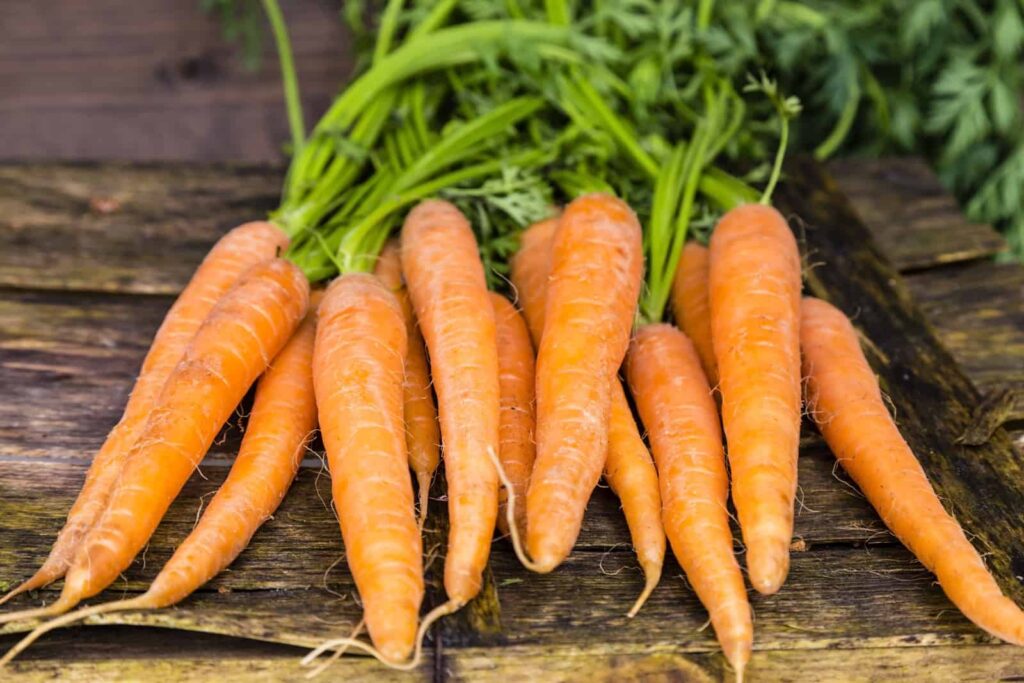
How to choose carrots
When choosing carrots, look for those whose skins are both firm and smooth. Avoid carrots with cracks or those that are turning soft or have withered. If you buy carrots with their foliage attached, be sure that the leaves are moist and bright green. As a rule, it’s best to remove carrot leaves as soon as you get home because the leaves draw moisture from the roots.
- Select carrots that are brightly colored and well-shaped with smooth exteriors and closely trimmed tops. Avoid carrots that are flabby, soft, wilted, or split. The attached carrot greens should be bright green.
- Baby carrots should be moist and plump, not slimy, broken, or whitish.
Carrot flavor and harvest size
- Baby carrots will be young and tender but not as sweet as slightly older carrots. Mature carrots are unlikely to be sweet at all. Carrots lose flavor as they age.
- Tapered carrot varieties are ready to eat at about finger length and round varieties are ready to eat when they are about ¾ inch (19 mm) across. Short, round varieties generally are easier to grow and tend to be sweeter than the tapered varieties.
How to store carrots
- Carrots will keep in a perforated plastic bag or storage bin in the refrigerator for 10 days. Carrots kept longer will gradually lose their sweetness and rigidity.
- It is best to store carrots with their tops removed; otherwise, the roots may lose moisture and nutrients.
- Sliced and blanched carrots will keep in the refrigerator for 1 to 3 months. You can freeze sliced and blanched carrots for up to 6 months. Carrots pickled in vinegar brine (after boiling) will store for up to 1 year.
- In mild climates, carrots can be left in the soil unharvested until you are ready to use them.
- Store carrots away from apples, pears, potatoes, and other vegetables or fruits that create ethylene gas, which can cause carrots to become bitter.
How to prepare carrots
- Young carrots do not require peeling, but older carrots are best eaten peeled. Many nutrients are in the carrot’s skin, but so is any bitterness. The hardcore of older carrots should be removed.
- Carrots that are soft or limp can be re-crisped in a bowl of ice water.
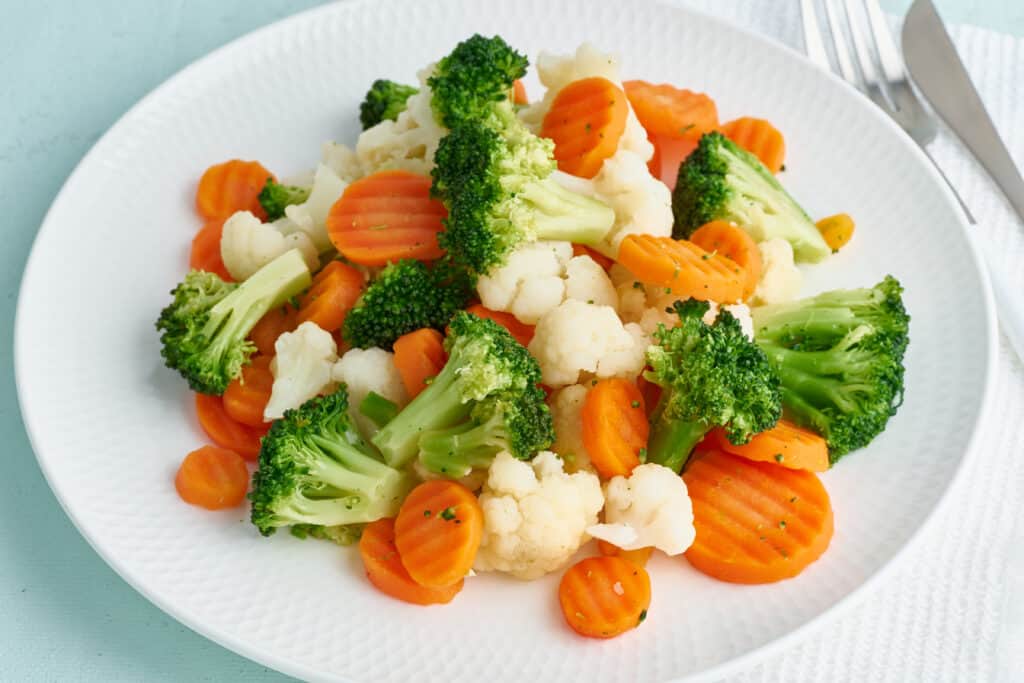
How to steam carrots
- Place a steamer basket in a saucepan. Add water to just below the bottom of the basket.
- Bring water to a boil.
- Add 1 pound of prepped carrots to a steamer basket. Cover and reduce heat.
- Cook the carrots until crisp-tender. Quater-inch slices will take 8 to 10 minutes. Quarter-inch strips will take 5 to 7 minutes. Baby carrots will take 8 to 10 minutes.
How to sauté carrots
- Clean the 2 pounds of carrots and cut them into very thin rounds.
- Put them in a saucepan with one teaspoon of salt, 1/2 stick butter, and 1/4 cup of water, and cook over medium heat. Shake the carrots occasionally to make sure they do not brown or cook too fast.
- Cook until they are just tender when pierced with the tip of a small knife.
- Add a large pinch of marjoram and a tablespoon of chopped parsley.
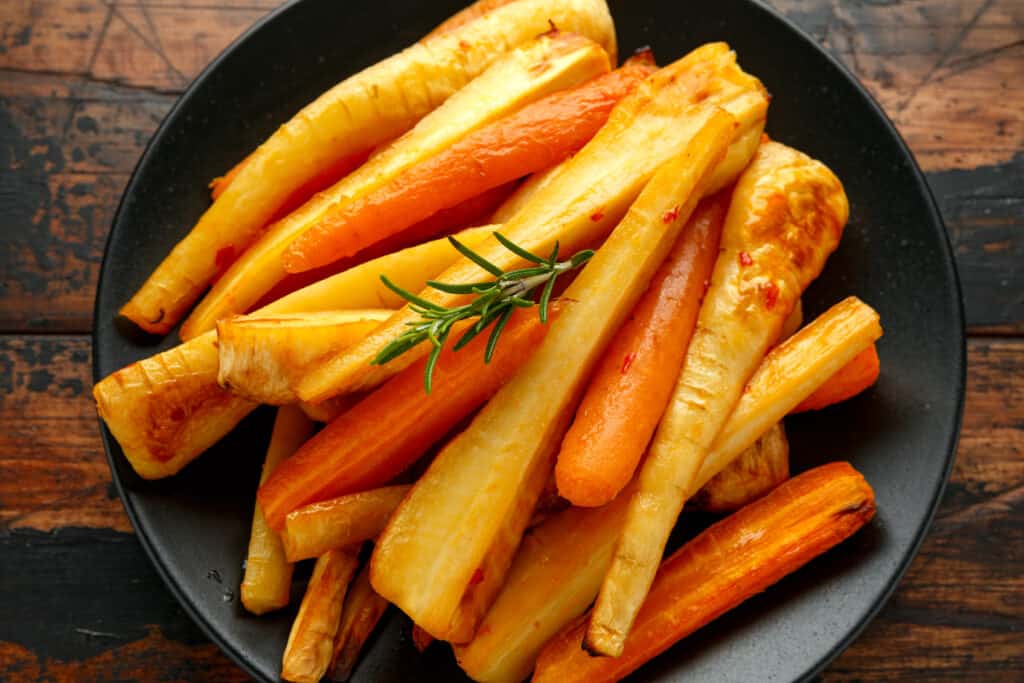
How to roast carrots
- Preheat the oven to 425 degrees F
- Wash and trim 1 pound of carrots.
- Cut large carrots into 1-inch pieces. Small or baby carrots can be cooked whole.
- Arrange cut carrots or baby carrots in a baking pan.
- Toss carrots with olive oil, salt, pepper, or other seasonings.
- Cover the pan with foil.
- Bake for 30 minutes. Remove the foil and stir the carrots.
- Return the carrots to the oven and bake, uncovered for 5 to 10 more minutes or until the carrots are tender.
How to microwave carrots
- Place 1 pound of carrots in a casserole dish with 2 tablespoons of water.
- Microwave, covered, on 100 percent power (high) until crisp-tender, stirring once. Quarter-inch slices will cook in 6 to 9 minutes. Quarter-inch strips will take 5 to 7 minutes. Baby carrots will take 7 to 9 minutes.
How to boil or simmer carrots
- Bring slightly salted water in a saucepan to a boil.
- Add 1 pound of carrots; cook until crisp-tender. Quarter-inch slices will take 7 to 9 minutes. Strips will take 4 to 6 minutes. Baby carrots will take 8 to 10 minutes for baby carrots
- Drain carrots and season to taste with salt and pepper.

How to glaze boiled carrots
- Boil the carrots as directed above.
- After the carrots are drained, toss the carrots with butter and salt, and pepper to taste.
- Add 1 to 2 tablespoons of honey or maple syrup to the buttered carrots and shake the pan over low heat until the butter and syrup combine to form a glaze on the carrots. Garnish with chopped parsley.
How to purée carrots
- Boil the carrots as directed above.
- Drain the carrots and put them through a blender, sieve, or food mill.
- Whip with butter and seasonings. for 2 pounds of carrots whip with 4 to 6 tablespoons of butter. If the mixture is on the dry side, beat with boiling milk as well as butter.
Carrots can be puréed with equal parts of potatoes, parsnips, and beets.
Carrot flavor partners
Carrots can be eaten raw and cooked in just about every way. If you are trying to match carrots up with other foods, here are some foods whose flavors have an affinity for carrots: beef, celery, chicken, chives, cinnamon, coriander, cumin, curry, dill, dried apricots, honey, onion, orange, raisins, rosemary, shallots, tarragon, thyme, and tomatoes.
- Carrots go well with beef, celery, chicken, chives, cinnamon, coriander, cumin, curry, dill, dried apricots, honey, onion, orange, raisins, rosemary, shallots, tarragon, thyme, and tomato.
Carrot nutrition
- Carrots are a good source of vitamin A, potassium, fiber, and beta-carotene.
- Twenty-five thin carrot sticks contain about 20 calories.

Get to know carrots
- A carrot is a swollen, fleshy taproot. The average carrot will be 6 to 8 inches (15-20 cm) long and ¾ inch (1.9 cm) in diameter. Carrots have finely divided fern-like leaves that sprout in a circle from the root top.
- Carrots are thought to have gotten their start somewhere between the eastern Mediterranean and Afghanistan. Wild carrots with their white, umbrella-shaped flowers called Queen Anne’s Lace grow throughout Europe and into Asia.
- The first cultivated carrots appeared more than 2,000 years ago around the Mediterranean. Those carrots had purple skins and yellow flesh. Primitive carrot roots were branched. Conical and tapered-rooted carrot varieties first appeared about 1,000 years ago.
- Moorish invaders took carrots to Spain in the twelfth century. Carrots reached England by the fifteenth century. During the fifteenth century, Dutch farmers improved the flavor of carrots and bred the first orange carrots to honor the Dutch Royal House of Orange. Orange carrots have been a standard ever since.
- The top carrot-producing counties are China, the United States, Poland, Japan, France, and England.
The botanical name of carrots is Daucus carota var. sativus.
Carrot Growing Hub
The Ultimate Guide to Growing Carrots from Seed to Harvest
1. Getting Started (Site & Timing)
- Where to Plant Carrots for the Best Root Development
- When to Plant Carrots: Timing for Every Season
- Carrots Seed Starting Tips
- How to Plant and Grow Carrots in Winter
- Grow Carrots Anytime of the Year in Five Steps
- How to Grow Carrots in Containers or Raised Beds
2. Planting & Varieties
- How to Plant and Space Carrots for Optimal Growth
- Carrot Varieties by Type: Best Picks for Home Gardeners
- Orange, Yellow, Red, Purple, and White Carrots: How to Choose the Right One
- Carrot Companion Plants: What Grows Well Together
3. Growing & Care
- Caring for Carrots Throughout the Growing Season
- How to Water Carrots the Right Way
- Carrot Crop Rotation: What to Plant Before and After
- Carrot and Parsnip Growing Problems: Troubleshooting
4. Harvest, Storage & Use
Carrot articles at Harvest to Table:
Grow Carrots Any Time of the Year in Five Steps
How to Harvest and Store Carrots
Carrot and Parsnip Growing Problems: Troubleshooting
Seven Ways to Cook and Serve Carrots
Baby Beets, Baby Carrots, and Snap Peas Salad
Articles of interest:
Best Herbs for Container Growing
Garden Planning Books at Amazon:
- Vegetable Garden Almanac & Planner
- Kitchen Garden Grower’s Guide Vegetable Encyclopedia
- Vegetable Garden Grower’s Guide
- Tomato Grower’s Answer Book
More kitchen tips:
Bring your harvest to the table. Kitchen prep tips and easy recipes for the vegetables you grow. Click below for vegetable prep and recipes you can use now.
- Almonds
- Apples
- Apricot
- Aprium
- Artichoke
- Arugula
- Asparagus
- Avocado
- Bamboo Shoots
- Banana
- Basil
- Beans, Dried
- Beans. Long
- Beans, Shell
- Beans, Snap
- Beets
- Bitter Melon
- Blackberry
- Bok Choy
- Broccoli
- Broccoli Raab
- Brussels Sprouts
- Cabbage
- Cardoon
- Carrots
- Cauliflower
- Celeriac
- Celery
- Chard
- Chayote Squash
- Cherimoya
- Cherries
- Chestnut
- Chickpea
- Chinese Cabbage
- Chives
- Cilantro
- Citron
- Clementine
- Collards
- Coriander
- Corn, Sweet
- Corn, Baby
- Corn Salad, Mache
- Cranberry
- Cress
- Cucumber
- Daikon
- Dandelion
- Dill
- Eggplant
- Endive, Belgian
- Endive and Escarole
- Fava Beans
- Fig
- Florence Fennel
- Garlic
- Ginger
- Grapefruit
- Grapes
- Guava
- Horseradish
- Jerusalem Artichoke
- Jicama
- Jujube
- Kale
- Kiwifruit
- Kohlrabi
- Kumquat
- Leeks
- Lemongrass
- Lemons
- Lettuce
- Lime
- Mache (Corn Salad)
- Mandarin Orange
- Mango
- Maple Syrup
- Marjoram
- Melons
- Michihili
- Mint
- Mizuna
- Mushrooms
- Mushrooms, Cremini
- Mustard Greens
- Napa Cabbage
- Nectarine
- Okra
- Olives
- Olive oil
- Onions
- Oranges
- Oregano
- Parsley
- Parsley Root
- Parsnips
- Passion Fruit
- Pawpaw
- Peaches
- Pears
- Peas, Garden Snap
- Peas, Snow
- Pei Tsai
- Peppers, Chili
- Peppers, Sweet
- Persimmon
- Pineapple
- Pineapple Guava
- Plantain
- Plums
- Pluots
- Pomegranate
- Potatoes
- Prickly Pear
- Pumpkin
- Quince
- Radicchio
- Radishes
- Raspberries
- Rosemary
- Rhubarb
- Rutabaga
- Sage
- Salsify
- Sauerkraut
- Savory
- Shallots
- Sorrel
- Spinach
- Squash, Summer
- Squash, Winter
- Strawberries
- Sunchokes
- Sunflower
- Sweet Potato
- Swiss Chard
- Tangerine
- Taro
- Tarragon
- Thyme
- Tomatillo
- Tomato
- Turnip
- Turnip Greens
- Yams

